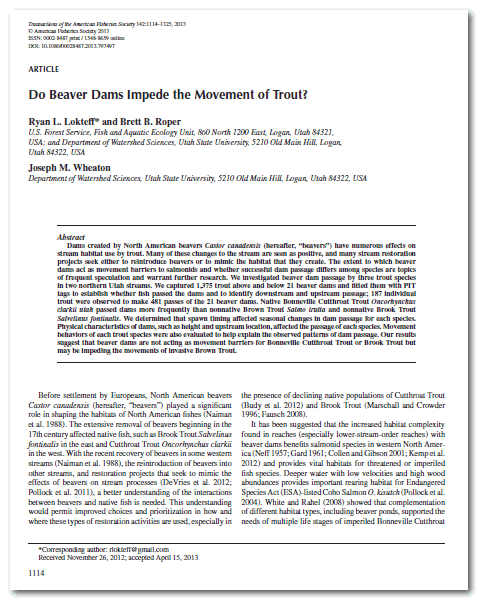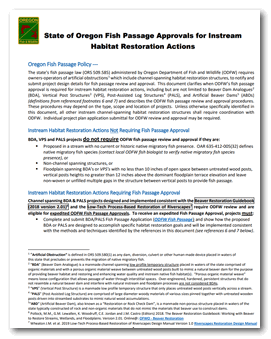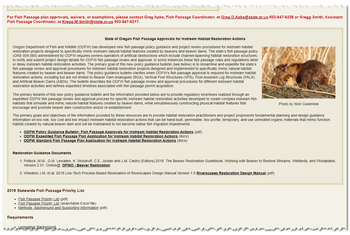Beaver Dam Activity Impacts on Fish
A review by Kemp et al. (2012) revealed that many perceived impacts of beaver dams on fish are based on conjecture and hearsay. This is not to say negative impacts never occur, but rather that biases among fish biologists and managers are common.
Reference:
Kemp PS, Worthington TA, Langford TEL, Tree ARJ, Gaywood MJ. 2012. Qualitative and quantitative effects of reintroduced beavers on stream fish. Fish and Fisheries 13(2):158–181. DOI: 10.1111/j.1467-2979.2011.00421.x
Fish Passage
Beaver dams can temporarily or seasonally act as barriers to fish movement. Too often, this is assumed to be harmful. In fact, many native fish that co-evolved with beaver pass these dams easily, especially during higher flows that coincide with spawning. Moreover, the habitat diversity created by beaver dams can outweigh potential migration impacts.
Studies on Fish Passage over Natural Beaver Dams
- Lokteff RL, Roper B, Wheaton JM. 2013. Do beaver dams impede the movement of trout? Transactions of American Fisheries Society. DOI: 10.1080/00028487.2013.797497
- Cutting KA et al. 2018. Linking beaver dam affected flow dynamics to upstream passage of Arctic grayling. Ecology and Evolution 8:12905–12917. DOI: 10.1002/ece3.4728
- Malison RL, Eby LA, Stanford JA. 2015. Canadian Journal of Fisheries and Aquatic Sciences 72:1639–1651. DOI: 10.1139/cjfas-2015-0147
- Malison RL, Kuzishchin KV, Stanford JA. 2016. PeerJ 4:e2403. DOI: 10.7717/peerj.2403
Studies on Fish Passage at BDAs
- Bouwes N et al. 2016. Ecosystem experiment reveals benefits of natural and simulated beaver dams to steelhead. Scientific Reports 6:28581. DOI: 10.1038/srep28581
- Pollock MM et al. 2019. A field experiment to assess passage of juvenile salmonids across beaver dams during low flow. bioRxiv 856252. DOI: 10.1101/856252
What Does Fish Passage Look Like?
Fish often use the mattresses in front of a dam to get over it:
Sometimes fish struggle, especially with breaches or unusual flows:
On Twitter:
In Utah’s Logan River, Lokteff et al. (2013) found native cutthroat trout navigated beaver dams more successfully than introduced brown trout.
See the tweet
Jumping is not the most common way fish cross dams, but sometimes they do, as seen here:
Another example under challenging conditions:
Other Fish Passage Resources
- Fish Passage - Who Cares? (Greg Apke, ODFW)
- Fish Passage Devices at Beaver Dams (Beaver Solutions)
- ICER Studies on Impact of Beaver
- Wild Trout Trust View on Beaver-Trout Interactions (PDF)
- Miistakis Institute Beavers and Fish Fact Sheet
Another World Fish Migration Day Tweet:
View here
State Policies Regarding Fish Passage
Oregon Department of Fish and Wildlife
Oregon's fish passage law (ORS 509.585) initially posed challenges for LTPBR permits. In 2020, ODFW updated its fish passage policy to support LTPBR structures when they follow design guidelines in the LTPBR manual.


